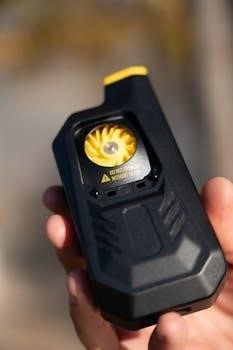prodigy brake controller instruction manual

Prodigy Brake Controller Instruction Manual⁚ A Comprehensive Guide
Welcome to the comprehensive guide for your Prodigy brake controller! This manual will help you understand the features‚ installation‚ operation‚ and troubleshooting of your Tekonsha Prodigy brake controller‚ ensuring safe and effective trailer braking.
Prodigy brake controllers‚ renowned for their reliability and ease of use‚ represent a significant advancement in trailer braking technology. Utilizing advanced sensor technology‚ Prodigy controllers provide smooth and proportional braking‚ enhancing safety and control while towing. These controllers are designed to activate trailer brakes in direct response to the tow vehicle’s deceleration‚ ensuring synchronized and effective stopping power.
Whether you’re a seasoned tower or new to hauling‚ understanding the functionality of your Prodigy brake controller is crucial. This guide will walk you through the various models‚ installation procedures‚ operational settings‚ and troubleshooting tips‚ empowering you to maximize the performance and safety of your towing setup. Prodigy controllers are adaptable to both electric and electric-over-hydraulic braking systems‚ offering versatility for diverse trailer types and towing needs.

Understanding Prodigy Models
The Prodigy line offers several models‚ each with unique features. This section will explore the key differences between the P2‚ P3‚ and RF models to help you choose the right controller.
Prodigy P2 Features and Operation
The Prodigy P2 is a popular brake controller known for its simplicity and effectiveness. It utilizes primary sensor technology‚ providing smooth braking in any situation. The P2 features an easy-to-use knob for setting power output‚ allowing effortless adjustment to your desired braking power.
A boost feature offers up to three levels of additional braking power‚ ideal for heavier loads. It supports both electric and electric-over-hydraulic braking systems. The manual override allows for manual activation of the trailer brakes when needed. The Prodigy P2 connects using a unique wiring connector‚ with options for pigtail or vehicle-specific harnesses. Its design prioritizes ease of use and reliable performance for various towing needs.
Prodigy P3 Features and Operation
The Prodigy P3 builds upon the P2‚ offering enhanced features and user experience. It includes up-front push-button controls for easy adjustment and monitoring of braking activity. Like the P2‚ it features a power output button for quick setting of desired braking force and a boost option with three levels for customized braking power‚ particularly useful when hauling heavier loads.
The P3 also offers manual override functionality. It shares wiring options with the P2‚ supporting both pigtail and vehicle-specific harnesses for flexible installation. Its advanced display provides real-time diagnostics and user-friendly settings‚ making it suitable for experienced towers seeking greater control and information.
Prodigy RF Wireless System
The Prodigy RF Wireless system represents a significant advancement‚ particularly beneficial for rental companies and fleet owners. It eliminates the need for under-dash wiring. The power module mounts directly to the trailer tongue and communicates wirelessly with a handheld remote via Bluetooth. This simplifies installation and allows for easy transfer between vehicles.
The remote offers features mirroring those of other Prodigy controllers‚ including boost settings for customized braking and manual override for emergency situations. The wireless design provides flexibility and convenience without sacrificing braking performance or safety. The handheld remote displays braking information and allows for easy adjustments on the go.
Installation Guide
Proper installation is crucial for optimal performance. This section covers wiring options‚ including pigtail and vehicle-specific harnesses‚ and provides guidance on securely mounting the controller within your vehicle for easy access and visibility.
Wiring Options⁚ Pigtail vs. Vehicle-Specific Harness
When installing your Prodigy brake controller‚ you have two primary wiring options⁚ using the included pigtail harness or opting for a vehicle-specific harness. The pigtail harness offers a universal solution‚ requiring you to manually connect the wires to your vehicle’s brake light‚ ground‚ power‚ and brake output wires‚ following a generic wiring guide.
Alternatively‚ a vehicle-specific harness simplifies the process‚ especially for vehicles equipped with a factory tow package and a 7-way connector. These harnesses are designed to be compatible with specific makes like Ford‚ Dodge‚ or GM‚ providing a plug-and-play connection‚ reducing the risk of wiring errors. Choosing the right option ensures a secure and reliable electrical connection for your brake controller.
Mounting the Controller
Properly mounting your Prodigy brake controller is crucial for its accurate operation. The controller should be mounted securely in the direction of travel‚ ensuring that the internal sensor can correctly detect deceleration. Choose a location where the display is easily viewable and the buttons are readily accessible while driving.
Avoid mounting locations that could obstruct the driver’s view or interfere with vehicle controls. Ensure the mounting surface is stable and free from excessive vibration. The Prodigy controller must be installed within specific angular constraints to maintain optimal performance. Failure to adhere to these mounting guidelines may impair the brake controller’s ability to provide smooth and reliable braking assistance.

Operation and Adjustment
This section details how to properly operate and adjust your Prodigy brake controller. Learn to set the power output‚ utilize the boost feature‚ and understand the manual override functionality for optimal braking performance.
Setting the Power Output
The Prodigy brake controller uses a knob or buttons to adjust the power output‚ determining the trailer’s braking force. Start by driving on a level surface at approximately 25 mph. Use the manual lever to activate the trailer brakes and adjust the power until the trailer brakes engage firmly without locking. If the trailer wheels lock‚ reduce the power setting. If the braking feels insufficient‚ increase the power. The goal is to achieve smooth‚ proportional braking where the trailer and tow vehicle slow down together. Fine-tune the power output based on the load and road conditions. Remember that the brake light signal plays a significant role‚ especially during strong deceleration. Adjustments might be needed based on whether the Tesla‚ for example‚ sends a signal during regen braking. Properly setting the power output ensures safe and controlled stops.
Using the Boost Feature
The Prodigy P2 and P3 models offer a “Boost” feature‚ providing additional braking power when needed. This feature is especially useful when hauling heavier loads or navigating steep grades. The Boost function typically has multiple levels (e.g.‚ B1‚ B2‚ B3)‚ each increasing the initial braking force applied to the trailer brakes. To use the Boost‚ press the boost button to cycle through the available levels. Experiment with different settings to find the optimal level for your specific towing situation. A higher boost setting delivers more aggressive initial braking. Consider the condition of your trailer brakes when selecting a boost level. Select your boost setting based on your towing situation‚ driving preference and condition of your trailer brakes. Engaging the boost feature will provide confidence and safety when braking.
Manual Override Functionality
The manual override lever on the Prodigy brake controller allows you to manually activate the trailer brakes independently of the tow vehicle’s brakes. This feature is crucial for testing the trailer brakes‚ stabilizing the trailer in sway situations‚ or as a secondary braking system in emergencies. To use the manual override‚ gently slide the lever to the left. The further you slide the lever‚ the more braking force is applied to the trailer. The power setting used just for manually braking? When would you use manually braking? Be cautious when using the manual override‚ as excessive or abrupt activation can cause the trailer wheels to lock up. Practice using the manual override in a safe‚ controlled environment to become familiar with its operation. It can also serve as a secondary emergency brake when parked on a very steep grade.
Troubleshooting
This section addresses common issues encountered with Prodigy brake controllers. We will cover understanding error codes like “NC” or “SH‚” and resolving intermittent error codes to ensure optimal brake controller performance.
Understanding Error Codes (e.g.‚ “NC‚” “SH”)
The Prodigy brake controller uses error codes to communicate potential issues. “NC” indicates no connection to trailer brakes‚ often due to wiring problems. “SH” signifies a short circuit in the brake wire‚ potentially caused by faulty wiring or non-Tekonsha testers.
When “NC” appears‚ inspect the trailer brake wiring‚ ensuring secure connections. For “SH‚” check for damaged wires or shorts in the brake circuit. Using Tekonsha-approved testers can prevent false “SH” readings.
Refer to the Prodigy instruction manual for a complete list of error codes and corresponding troubleshooting steps. Addressing these codes promptly ensures safe and reliable trailer braking. These may include checking the pigtail wiring harness or vehicle-specific harness.
Remember to consult the FAQs for more information on brake controller operation.
Addressing Intermittent Error Codes
Intermittent error codes on your Prodigy brake controller can be frustrating‚ often pointing to elusive connection or wiring issues. Start by meticulously inspecting all wiring connections between the controller‚ tow vehicle‚ and trailer. Look for loose‚ corroded‚ or damaged wires. Ensure the ground connection is secure and free from corrosion.
Vibration during travel can cause temporary disconnections. Try re-securing the controller mounting and wiring harnesses. Check the trailer brake magnets for wear or damage‚ as these can sometimes cause intermittent shorts.
If using a vehicle-specific harness‚ ensure it’s properly seated and compatible with your vehicle. Consider consulting a professional if the problem persists‚ as specialized diagnostic tools may be required. Remember‚ consistent and reliable connections are crucial for safe trailer braking‚ and addressing intermittent errors promptly prevents potential hazards.

Advanced Usage
Explore advanced techniques to maximize your Prodigy brake controller’s potential. Fine-tune settings for optimal performance. Master the manual lever for specialized braking scenarios. Understand nuanced functionalities for enhanced control and safety while towing.
Optimal Brake Controller Settings
Achieving optimal brake controller settings is crucial for safe and effective towing. Begin by understanding the relationship between your tow vehicle‚ trailer weight‚ and braking requirements; The Prodigy series allows for customized braking through boost settings‚ enabling different levels of personalized braking power. Start with a lower boost setting and gradually increase it until you achieve smooth‚ controlled stops without trailer sway or wheel lockup.
Adjust the power output knob while test driving at approximately 25 mph‚ using the manual lever to feel the trailer brakes engage. The goal is to set the controller just below the point where the trailer wheels lock up. Consider factors like road conditions and load distribution when fine-tuning your settings for the safest towing experience.
Manual Lever Functionality Explained
The manual lever on your Prodigy brake controller provides independent control of the trailer brakes. By sliding the lever‚ you can activate the trailer brakes separately from the tow vehicle’s brakes. This feature is useful in several situations. It can be used to test the trailer brakes before a trip‚ allowing you to verify they are functioning correctly. In emergency situations‚ the manual lever can be used to apply the trailer brakes for added stopping power or to correct trailer sway.
The power setting on the controller influences the intensity of braking when using the manual lever. Practice using the manual lever in a controlled environment to familiarize yourself with its response. Remember that using the manual lever applies the trailer brakes only‚ so adjust your driving accordingly.

Safety and Maintenance
Prioritizing safety and maintaining your Prodigy brake controller are crucial for reliable performance and preventing accidents. Regularly inspect the wiring connections for corrosion‚ damage‚ or looseness. Ensure the controller is securely mounted and free from obstructions. Before each trip‚ test the trailer brakes using the manual override lever at low speeds to verify proper function. Pay attention to any unusual noises or vibrations during braking‚ which may indicate issues with the trailer brakes or the controller itself.
Keep the controller clean and dry‚ avoiding exposure to extreme temperatures or moisture. If you encounter any persistent problems or error codes‚ consult a qualified technician for diagnosis and repair. Adhering to these safety and maintenance guidelines will help ensure your Prodigy brake controller provides years of safe and dependable service.